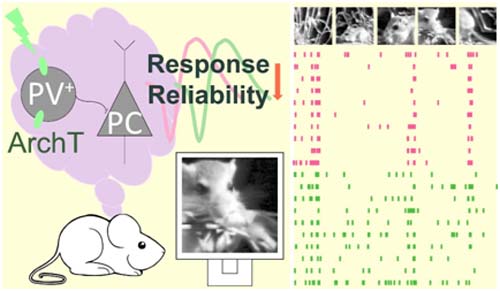Time:2015-04-16
Reliability of neuronal responses is essential for the fidelity of sensory coding. Previous studies in visual cortex, auditory cortex, somatosensory cortex, and hippocampus suggested that inhibitory neural circuits play important roles in regulating response reliability. However, inhibitory neurons are diverse and it is unclear how specific types of inhibitory neuron contribute to response reliability.
A recent study from Dr. YAO Haishan's lab at the Institute of Neuroscience, Shanghai Institutes for Biological Sciences, demonstrated that Parvalbumin (PV)-expressing interneurons play an important role in controlling the response reliability of excitatory neurons in the primary visual cortex (V1).
In this study, using optogenetics to manipulate the activity of specific types of inhibitory interneurons, Dr. YAO's group reported that suppressing the activity of parvalbumin (PV)- but not somatostatin (SOM)-expressing interneurons reduced the reliability of V1 responses to natural stimuli. PV suppression increased low-rate neuronal responses and decreased high-rate neuronal responses, leading to a reduction in the signal-to-noise ratio (SNR). In contrast, SOM suppression increased firing rates across all firing rate levels, without significant change in SNR. They further showed that suppressing the activities of PV but not SOM interneurons impaired neural discrimination of different natural stimuli. These results thus unravel critical roles of PV interneurons in regulating response reliability and SNR in the visual cortex.
This research entitled "Control of response reliability by parvalbumin-expressing interneurons in visual cortex" was published in Nature Communications on April 14th, 2015. This work was carried out by graduate students ZHU Yingjie, QIAO Wenhui (equal contribution first author), LIU Kefei and colleagues under the supervision of Dr. YAO Haishan. The study was supported by grants from the 973 program and the State Key Laboratory of Neuroscience.

Figure legend: Suppressing the activity of PV interneurons resulted in a reduction in the response reliability of excitatory neurons. Red spikes, without PV suppression; green spikes, with PV suppression.
 附件下载:
附件下载: